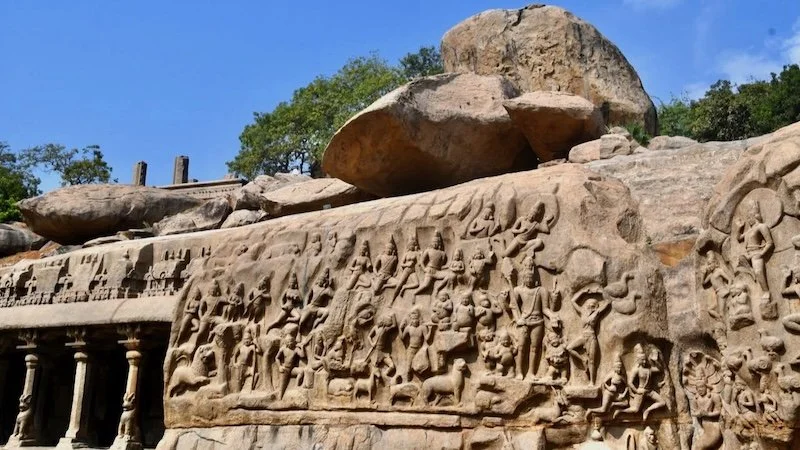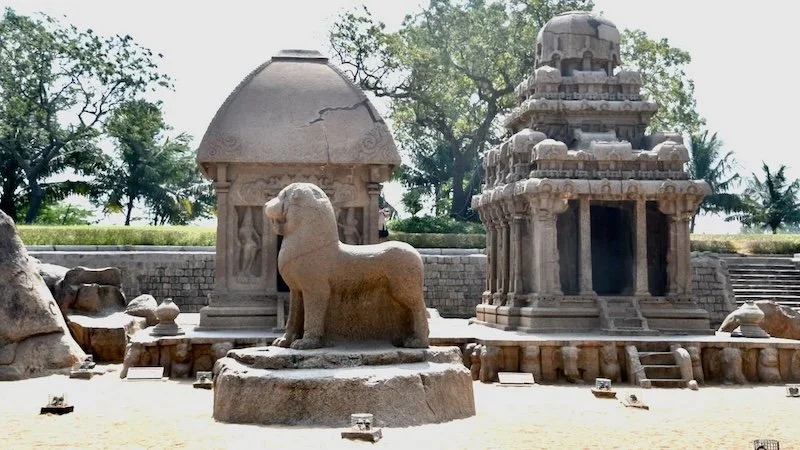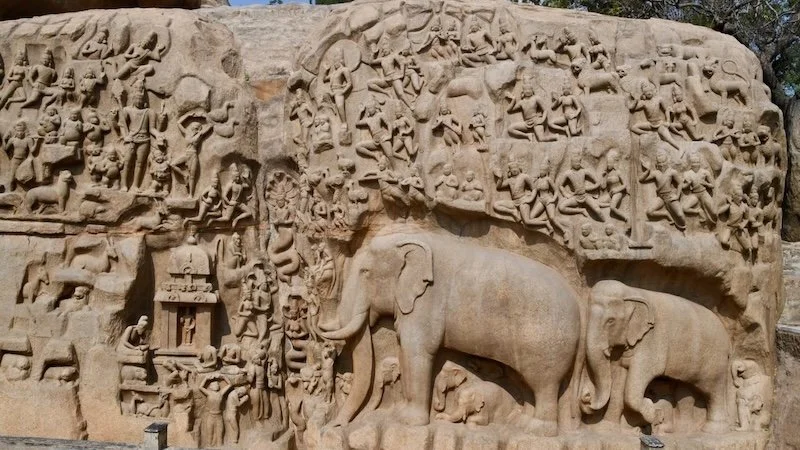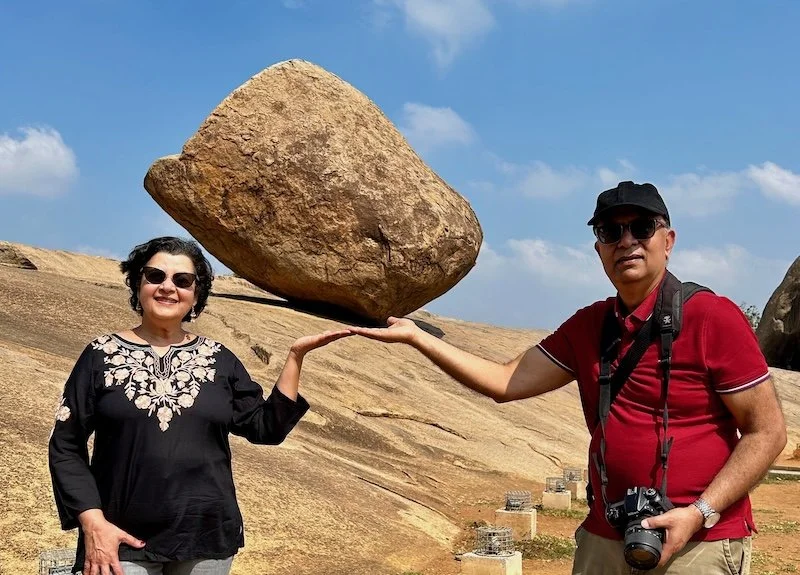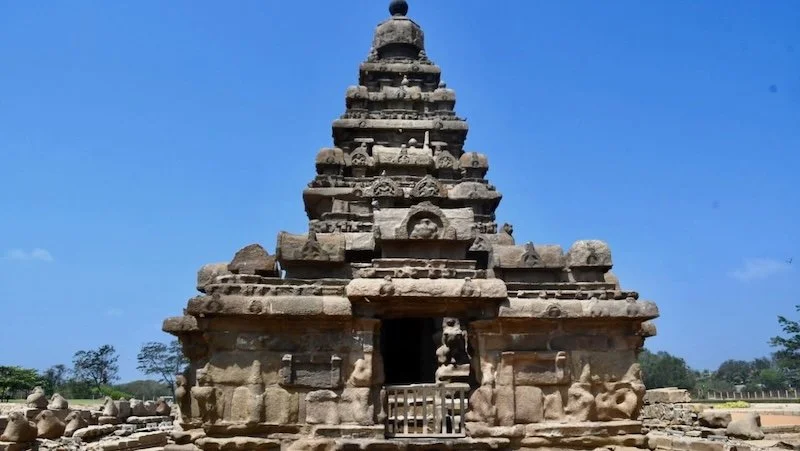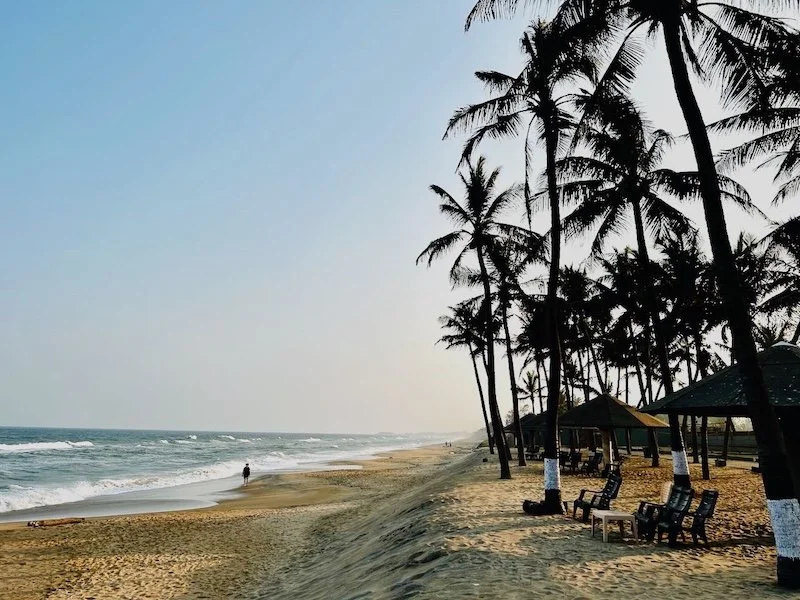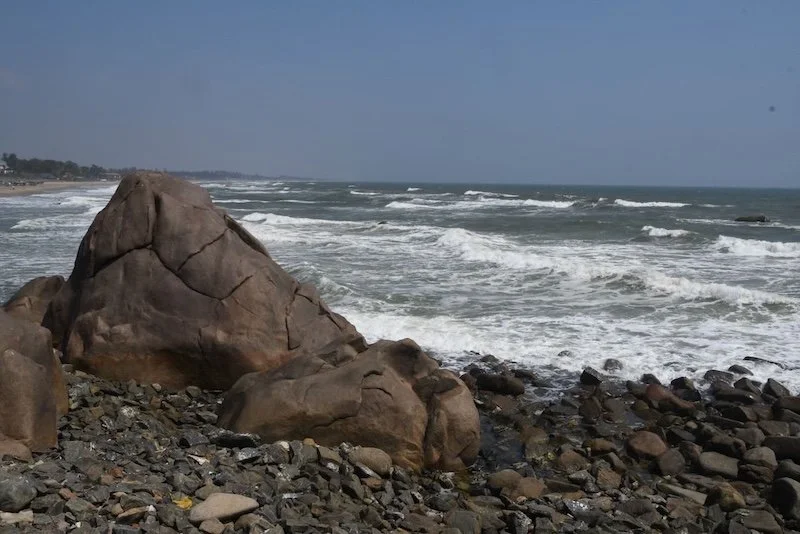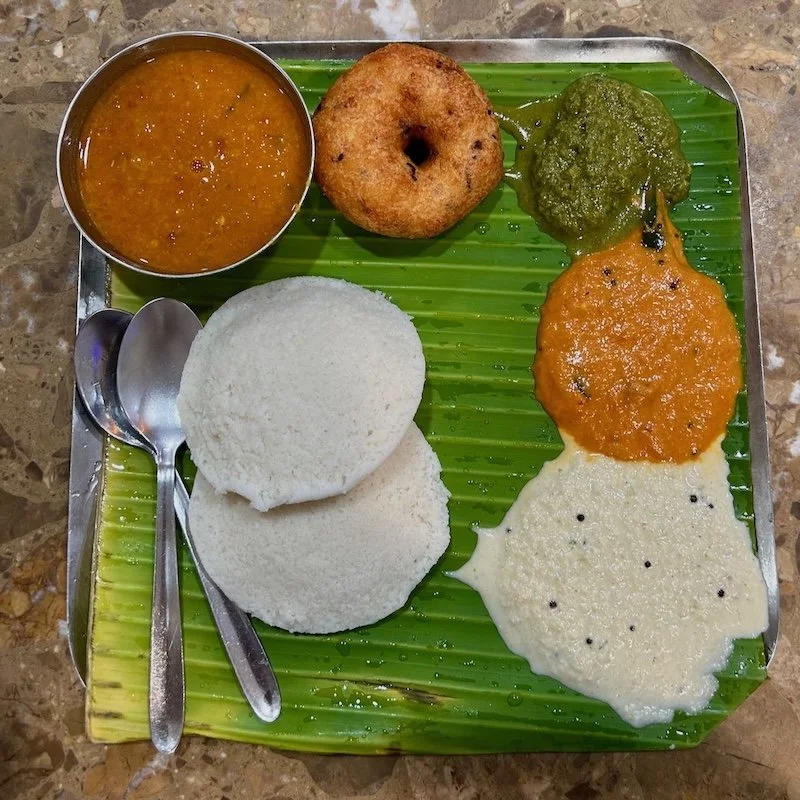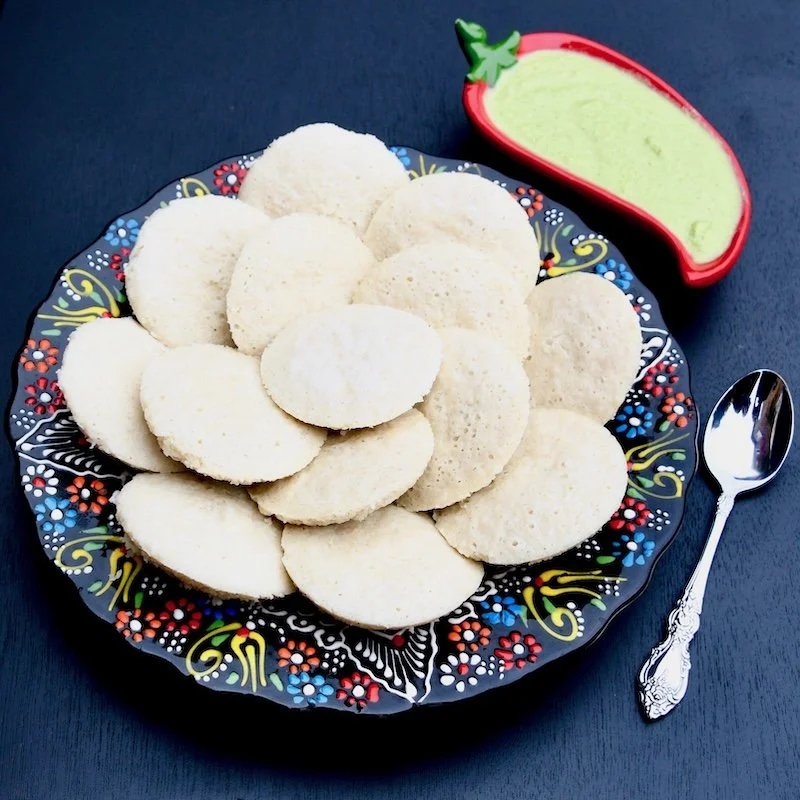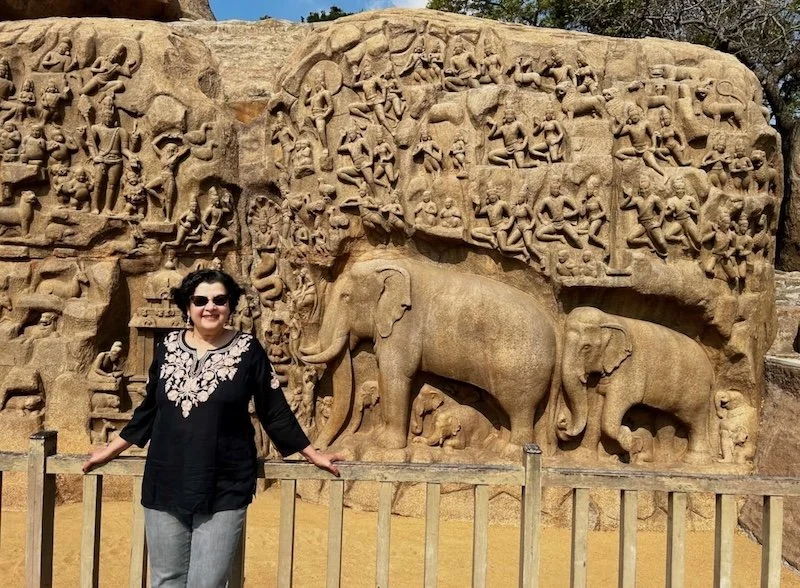Idlis In Mahabalipuram
Mahabalipuram left us awe struck. Blending mythology, art and architecture in a stunning tapestry, every rock, every carving, every monument tells a story centuries old. Built in the 7th century, Mahabalipuram is located on the eastern coast of India, about an hour’s drive south of the city of Chennai.
There are about 40 different monuments in the complex, including temples, sculptures of animals, and chariots carved out of stone. Each structure is a single rock that has been chiselled into its present shape, requiring an incredible amount of effort. Giant lions, bulls and elephants stand between the buildings. Some temples are housed in caves set into the rock face, their interiors covered with sculpted scenes from mythology.
The immense open air carving, Arjuna’s Penance illustrates so many different Hindu legends that we could have stood there for hours studying each sculpture. Engraved on two huge boulders the size of a three-story building, it is one of the largest relief carvings in the world. The cleft down the middle of the giant rock represents the Ganges river descending from heaven to earth, summoned by the sage Bhagiratha who stands on one leg performing an arduous act of penance. Gods and goddesses battle demons while a herd of elephants ambles peacefully through the scene.
One of the biggest attractions in Mahabalipuram is a massive boulder, 20 ft across, that balances precariously on one corner, looking as if the lightest touch would topple it over. It has stood on the same spot for over a millennium, inviting disbelief from onlookers. It is known popularly as Krishna’s Butterball, from the popular legends of the god Krishna who as a child would steal butter from his mother’s pot.
Mahabalipuram was always a busy port, even before the temples were constructed. Roman ships pulled into its harbour in the first century and Indian fleets departed from here for China in the seventh and eight centuries. The Shore Temple is the sole survivor of a group of temples built near the old port, which would have been the first landmark that ships sighted. Marco Polo saw the temples and wrote about them when he sailed past this coast in the thirteenth century. Rising sea levels have submerged many of the temples, but when the water retreated during the tsunami of 2004 large stone structures were revealed on the ocean bed for a brief moment .
The idyllic beaches near Mahabalipuram make this a popular spot for resorts. The sand stretches out for miles and the warm waters of the Indian Ocean invite you to dip your toes in them. Otherwise you can pull up a chair under the swaying palm trees and take a gentle doze. And when dusk falls, you can have dinner right on the beach, choosing from the variety of fresh fish on offer, grilled on the spot in a haze of spice and smoke. That’s just what we did when we stayed at the charming Ideal Beach Resort. The memory of the delicious food, the sound of the waves gently lapping at our feet and the congenial conversation with friends around the table still lives with us.
The cuisine of this coastal area features a lot of spicy seafood dishes such as shrimp masala, fish curry or fish fry, along with other traditional South Indian dishes like idlis and dosas. I am quite addicted to idlis which are deliciously soft, steamed savoury rice cakes made from a fermented batter of rice and lentils. Spongy, squishy idlis are a wonderful, healthy way to start the day and we made sure to do that every day! Idlis are usually accompanied by a variety of chutneys and sambhar, which add spicy notes to your breakfast. Idlis are readily available at ridiculously cheap prices in restaurants throughout South India and make a great breakfast or snack. If you’d like to try your hand at making them at home, they provide a fascinating experiment in fermentation and are quite easy to prepare.
This is my mother’s foolproof recipe that I have been making for years. All of these ingredients can be found in any Indian grocery store. You do need an idli steamer for these idlis, which can easily be found online or at Indian grocery stores. Serve your idlis with coconut chutney or dip them in Sambhar for the perfect breakfast!
Rice Idlis
1 1/4 cup Idli rava (coarsely ground par boiled idli rice)
3/4 cup white urad dal (skinless split black gram)
1/4 cup dry poha (flattened rice flakes), or cooked rice
1 tsp fenugreek seeds
Salt to taste
Place idli rava, urad dal and poha (if using) in separate deep bowls. Add the fenugreek seeds to the dal when soaking, so they too can hydrate properly.
Wash under running water a couple times, then cover with water and soak for 4 - 6 hours or up to overnight.
When ready to grind the batter, drain water from all three bowls.
Add the dal with its soaking fenugreek seeds and the poha (if using) or cooked rice to the jar of a blender.
Add 1 cup water and salt to taste. Grind until smooth and fluffy, scraping the sides of the jar to incorporate everything.
Add the drained idli rava to the blender jar along with 1 cup water and give it a few quick pulses to blend lightly. The batter should not be too smooth, the idli rava should retain some of its coarse texture and should be the consistency of a thick pancake batter.
Transfer batter to a very deep, large bowl that can accommodate the fermentation process as the batter rises.
Switch on just the light in your oven to keep it warm. Place bowl with batter in oven, cover with a lid. Do not turn on the heat. Leave batter overnight in warm oven.
The next day, remove lid and check on batter. It should be fermented, bubbly and risen. Cover and refrigerate batter if not using right away.
Remove batter from fridge and bring to room temperature for one hour before using it. Stir batter very lightly to incorporate.
Prepare idli steamer by filling the pot a quarter of the way and simmering covered over medium low heat. Grease idli moulds lightly. Fill moulds with batter to slightly below the brim, and steam covered for 10-12 minutes, or until a skewer inserted in the centre comes out clean.
Remove idli moulds from steamer, cool for a min or two, then gently slide a knife around each idli to loosen and remove it. Repeat with remaining batter.
Makes 12-14 idlis
